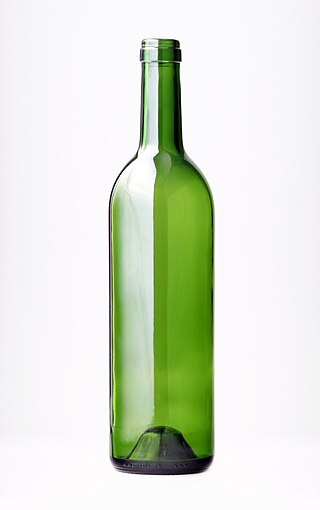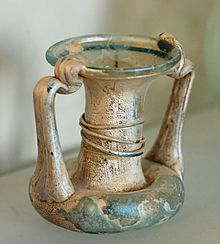
A test tube, also known as a culture tube or sample tube, is a common piece of laboratory glassware consisting of a finger-like length of glass or clear plastic tubing, open at the top and closed at the bottom.

A syringe is a simple reciprocating pump consisting of a plunger that fits tightly within a cylindrical tube called a barrel. The plunger can be linearly pulled and pushed along the inside of the tube, allowing the syringe to take in and expel liquid or gas through a discharge orifice at the front (open) end of the tube. The open end of the syringe may be fitted with a hypodermic needle, a nozzle or tubing to direct the flow into and out of the barrel. Syringes are frequently used in clinical medicine to administer injections, infuse intravenous therapy into the bloodstream, apply compounds such as glue or lubricant, and draw/measure liquids. There are also prefilled syringes.

A bottle is a narrow-necked container made of an impermeable material in various shapes and sizes that stores and transports liquids. Its mouth, at the bottling line, can be sealed with an internal stopper, an external bottle cap, a closure, or induction sealing.

A carboy, also known as a demijohn or a lady jeanne, is a rigid container with a typical capacity of 4 to 60 litres. Carboys are primarily used for transporting liquids, often drinking water or chemicals.

A bottle cap or bottle top is a closure for the top opening of a bottle. A cap is sometimes colorfully decorated with the logo of the brand of contents. Plastic caps are used for plastic bottles, while metal with plastic backing is used for glass; plastic caps are commonly made from polyethylene or polypropylene, while metal caps are usually either steel or aluminum. Plastic caps may have a pour spout. Flip-Top caps like Flapper closures provide controlled dispensing of dry products. Caps for plastic bottles are often made of a different type of plastic from the bottle.

A jar is a rigid, cylindrical or slightly conical container, typically made of glass, ceramic, or plastic, with a wide mouth or opening that can be closed with a lid, screw cap, lug cap, cork stopper, roll-on cap, crimp-on cap, press-on cap, plastic shrink, heat sealed lidding film, an inner seal, a tamper-evident band, or other suitable means. The English word "jar" originates from the Arabic word jarra, which means an earthen pot or vessel.

A stopper, bung, or cork is a cylindrical or conical closure used to seal a container, such as a bottle, tube, or barrel.

A closure is a device used to close or seal a container such as a bottle, jug, jar, tube, or can. A closure may be a cap, cover, lid, plug, liner, or the like. The part of the container to which the closure is applied is called the finish.

An ampoule is a small sealed vial which is used to contain and preserve a sample, usually a solid or liquid. Ampoules are usually made of glass.
Wine accessories are things that may be used in the storage or serving of wine. Wine accessories include many items such as wine glasses, corkscrews, and wine racks.

A glass bottle is a bottle made from glass. Glass bottles can vary in size considerably, but are most commonly found in sizes ranging between about 200 millilitres and 1.5 litres. Common uses for glass bottles include food condiments, soda, liquor, cosmetics, pickling and preservatives; they are occasionally also notably used for the informal distribution of notes. These types of bottles are utilitarian and serve a purpose in commercial industries.

A jug is a type of container commonly used to hold liquids. It has an opening, sometimes narrow, from which to pour or drink, and has a handle, and often a pouring lip. Jugs throughout history have been made of metal, ceramic, or glass, and plastic is now common.

Induction sealing is the process of bonding thermoplastic materials by induction heating. This involves controlled heating an electrically conducting object by electromagnetic induction, through heat generated in the object by eddy currents.

Ground glass joints are used in laboratories to quickly and easily fit leak-tight apparatus together from interchangeable commonly available parts. For example, a round bottom flask, Liebig condenser, and oil bubbler with ground glass joints may be rapidly fitted together to reflux a reaction mixture. This is a large improvement compared with older methods of custom-made glassware, which was time-consuming and expensive, or the use of less chemical resistant and heat resistant corks or rubber bungs and glass tubes as joints, which took time to prepare as well.
Pharmaceutical formulation, in pharmaceutics, is the process in which different chemical substances, including the active drug, are combined to produce a final medicinal product. The word formulation is often used in a way that includes dosage form.

A canteen is a reusable drinking water bottle designed to be used by hikers, campers, soldiers, bush firefighters, and workers in the field. It is usually fitted with a shoulder strap or means for fastening it to a belt, and may be covered with a cloth bag and padding to protect the bottle and insulate the contents. If the padding is soaked with water, evaporative cooling can help keep the contents of the bottle cool. Many canteens also include a nested canteen cup.

Drug packaging is process of packing pharmaceutical preparations for distribution, and the physical packaging in which they are stored. It involves all of the operations from production through drug distribution channels to the end consumer.

Reagent bottles, also known as media bottles or graduated bottles, are containers made of glass, plastic, borosilicate or related substances, and topped by special caps or stoppers. They are intended to contain chemicals in liquid or powder form for laboratories and stored in cabinets or on shelves. Some reagent bottles are tinted amber (actinic), brown or red to protect light-sensitive chemical compounds from visible light, ultraviolet and infrared radiation which may alter them; other bottles are tinted blue or uranium green for decorative purposes -mostly vintage apothecary sets, from centuries in which a doctor or apothecary was a prominent figure. The bottles are called "graduated" when they have marks on the sides indicating the approximate amount of liquid at a given level within the container. A reagent bottle is a type of laboratory glassware. The term "reagent" refers to a substance that is part of a chemical reaction, and "media" is the plural form of "medium" which refers to the liquid or gas which a reaction happens within, or is a processing chemical tool such as a flux.

A flacon is a small, often decorative, bottle. It has an opening seal or stopper and is designed to hold valuable liquids which may deteriorate upon contact with the air. They are widespread in the food industry, the pharmaceutical industry, and the cosmetics industry. They are generally made of glass for perfumes, but can also be made out of plastics for other uses.




















